GreenEarth Corporation: Charlotte Mills Valuation & Acquisition
VerifiedAdded on 2023/04/20
|10
|1985
|318
Case Study
AI Summary
This case study provides a comprehensive financial analysis of GreenEarth Corporation's potential acquisition of Charlotte Mills. It begins by estimating the valuation of Charlotte Mills, evaluating the components of WACC, and determining the impact of tax basis changes. It then assesses the value of the scenario after five years, considering expansion projects and additional costs. The study also explores the strategic reasons for the transaction and advises on the financing of the deal, recommending a combination of credit line and common stock issue. Furthermore, it examines the potential impact of existing mortgage debt and debentures on the financing decision. The analysis includes detailed calculations of free cash flow, NPV, terminal value, and equity value under various scenarios, providing a robust assessment of the acquisition's financial viability. Desklib offers similar solved assignments and study resources for students.
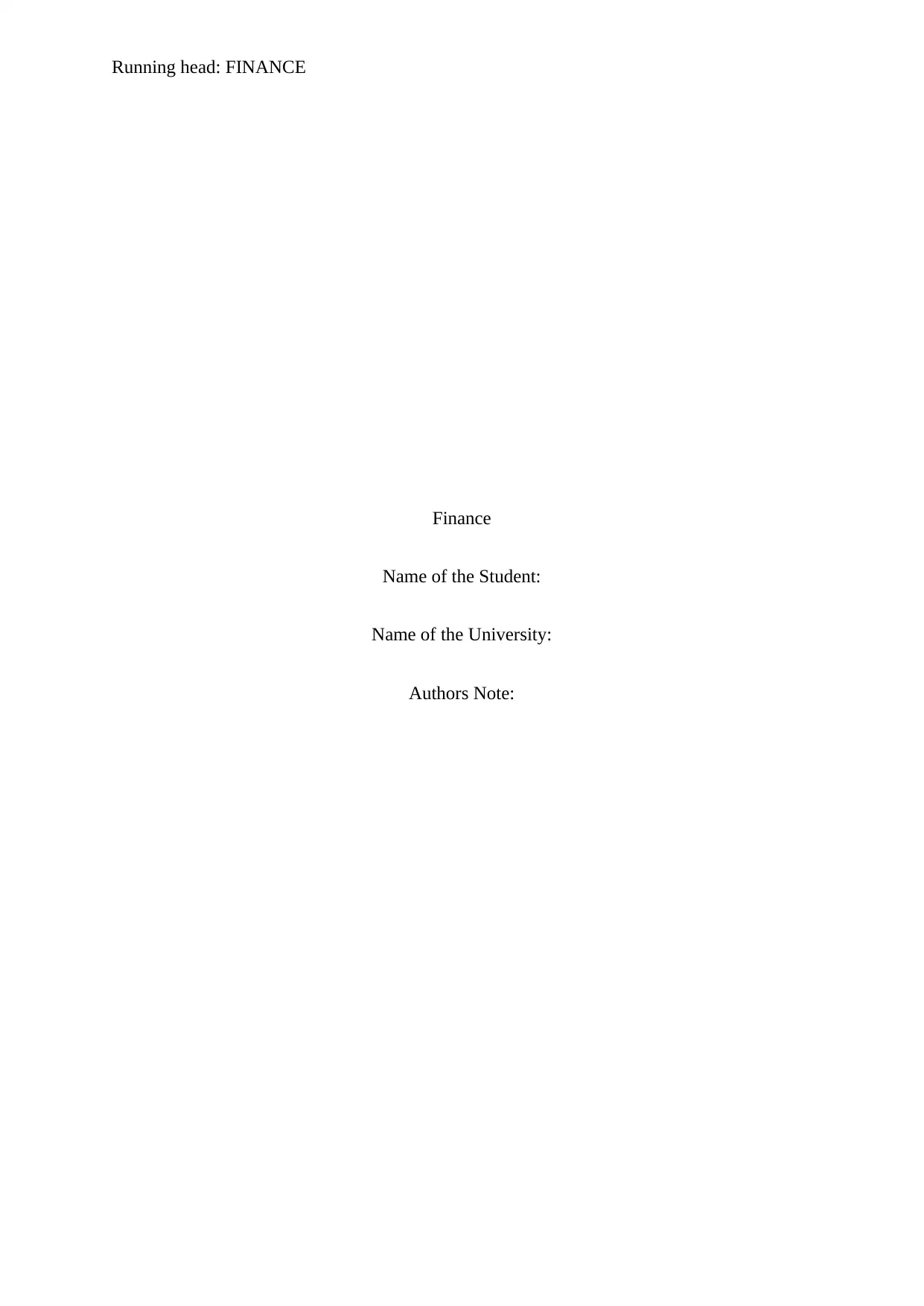
Running head: FINANCE
Finance
Name of the Student:
Name of the University:
Authors Note:
Finance
Name of the Student:
Name of the University:
Authors Note:
Paraphrase This Document
Need a fresh take? Get an instant paraphrase of this document with our AI Paraphraser
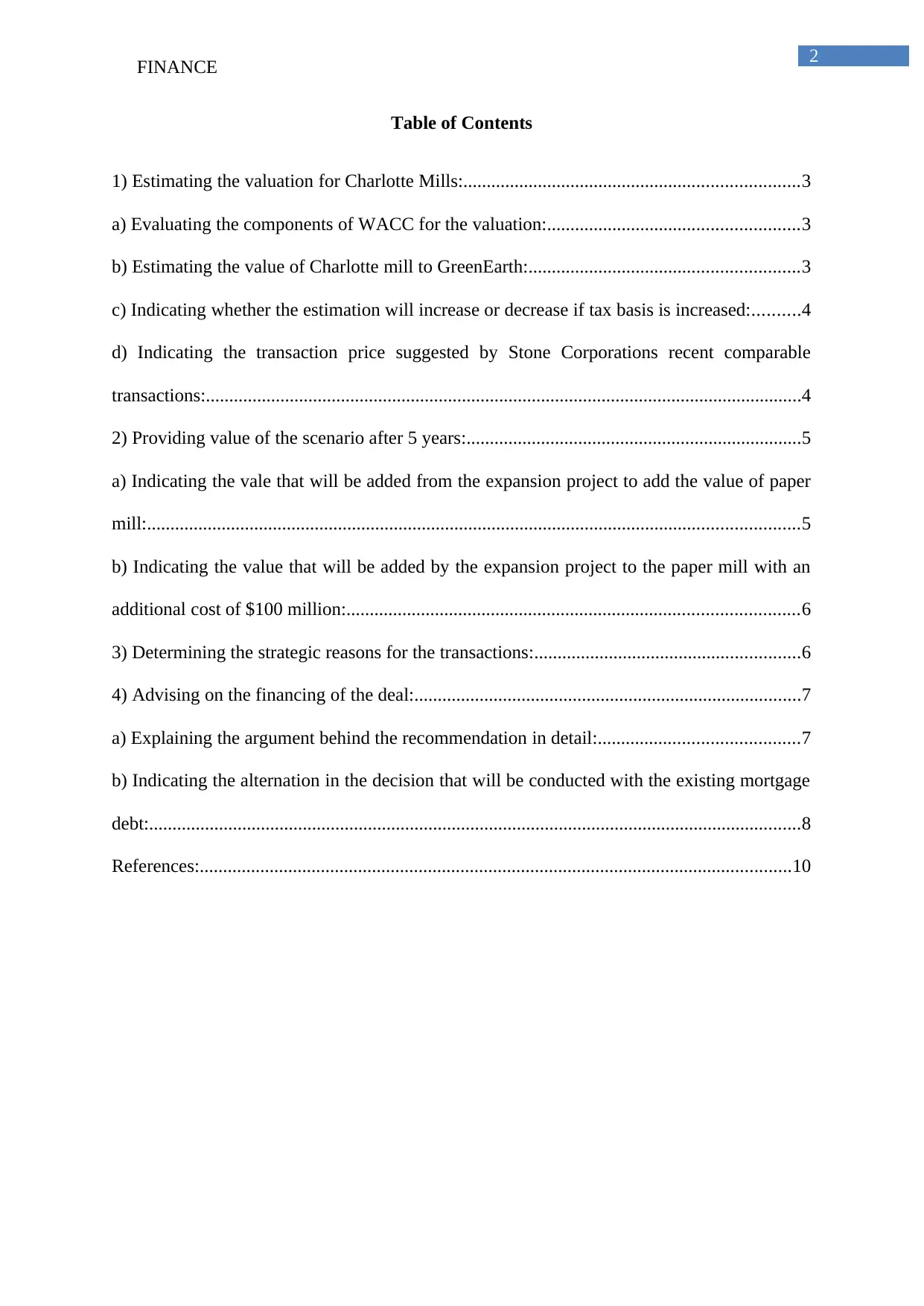
FINANCE 2
Table of Contents
1) Estimating the valuation for Charlotte Mills:........................................................................3
a) Evaluating the components of WACC for the valuation:......................................................3
b) Estimating the value of Charlotte mill to GreenEarth:..........................................................3
c) Indicating whether the estimation will increase or decrease if tax basis is increased:..........4
d) Indicating the transaction price suggested by Stone Corporations recent comparable
transactions:................................................................................................................................4
2) Providing value of the scenario after 5 years:........................................................................5
a) Indicating the vale that will be added from the expansion project to add the value of paper
mill:............................................................................................................................................5
b) Indicating the value that will be added by the expansion project to the paper mill with an
additional cost of $100 million:.................................................................................................6
3) Determining the strategic reasons for the transactions:.........................................................6
4) Advising on the financing of the deal:...................................................................................7
a) Explaining the argument behind the recommendation in detail:...........................................7
b) Indicating the alternation in the decision that will be conducted with the existing mortgage
debt:............................................................................................................................................8
References:...............................................................................................................................10
Table of Contents
1) Estimating the valuation for Charlotte Mills:........................................................................3
a) Evaluating the components of WACC for the valuation:......................................................3
b) Estimating the value of Charlotte mill to GreenEarth:..........................................................3
c) Indicating whether the estimation will increase or decrease if tax basis is increased:..........4
d) Indicating the transaction price suggested by Stone Corporations recent comparable
transactions:................................................................................................................................4
2) Providing value of the scenario after 5 years:........................................................................5
a) Indicating the vale that will be added from the expansion project to add the value of paper
mill:............................................................................................................................................5
b) Indicating the value that will be added by the expansion project to the paper mill with an
additional cost of $100 million:.................................................................................................6
3) Determining the strategic reasons for the transactions:.........................................................6
4) Advising on the financing of the deal:...................................................................................7
a) Explaining the argument behind the recommendation in detail:...........................................7
b) Indicating the alternation in the decision that will be conducted with the existing mortgage
debt:............................................................................................................................................8
References:...............................................................................................................................10

FINANCE 3
1) Estimating the valuation for Charlotte Mills:
a) Evaluating the components of WACC for the valuation:
Particular Value
Corporate Bond 42.00%
Yield 9.50%
Equity 58.00%
Risk free rate 8.49%
Beta 1.35
Market Premium 7.00%
Cost of equity 17.94%
Tax 34.00%
WACC 13.04%
There are specific components of WACC, which is used for detecting the level of cost
of capital required for GreenEarth. In addition, from the evaluation it can be detected that
WACC is mainly at the levels of 13.04%, which is calculated from cot of equity and cost of
capital. Moreover, the major components of WACC is Debt, Equity and tax rate, which helps
in determining the cost of capital of the firm. The corporate bond composition is 42%, while
equity is at 58%. The cost of debt is calculated at 9.50%, while the cost of equity is 17.94%
with a tax rate of 34%.
b) Estimating the value of Charlotte mill to GreenEarth:
Charlotte Mill 1994 1995 1996 1997 1998
Capex 18 18 18 18 18
Change in working
capital 19.2 33 19.2 9.9 8.1
Free Cash flow 113.1 145.7
223.
2 219.3 223.1
WACC 15%
Growth 5%
NPV $591.58
Terminal Value $2,231.00
1) Estimating the valuation for Charlotte Mills:
a) Evaluating the components of WACC for the valuation:
Particular Value
Corporate Bond 42.00%
Yield 9.50%
Equity 58.00%
Risk free rate 8.49%
Beta 1.35
Market Premium 7.00%
Cost of equity 17.94%
Tax 34.00%
WACC 13.04%
There are specific components of WACC, which is used for detecting the level of cost
of capital required for GreenEarth. In addition, from the evaluation it can be detected that
WACC is mainly at the levels of 13.04%, which is calculated from cot of equity and cost of
capital. Moreover, the major components of WACC is Debt, Equity and tax rate, which helps
in determining the cost of capital of the firm. The corporate bond composition is 42%, while
equity is at 58%. The cost of debt is calculated at 9.50%, while the cost of equity is 17.94%
with a tax rate of 34%.
b) Estimating the value of Charlotte mill to GreenEarth:
Charlotte Mill 1994 1995 1996 1997 1998
Capex 18 18 18 18 18
Change in working
capital 19.2 33 19.2 9.9 8.1
Free Cash flow 113.1 145.7
223.
2 219.3 223.1
WACC 15%
Growth 5%
NPV $591.58
Terminal Value $2,231.00
⊘ This is a preview!⊘
Do you want full access?
Subscribe today to unlock all pages.

Trusted by 1+ million students worldwide
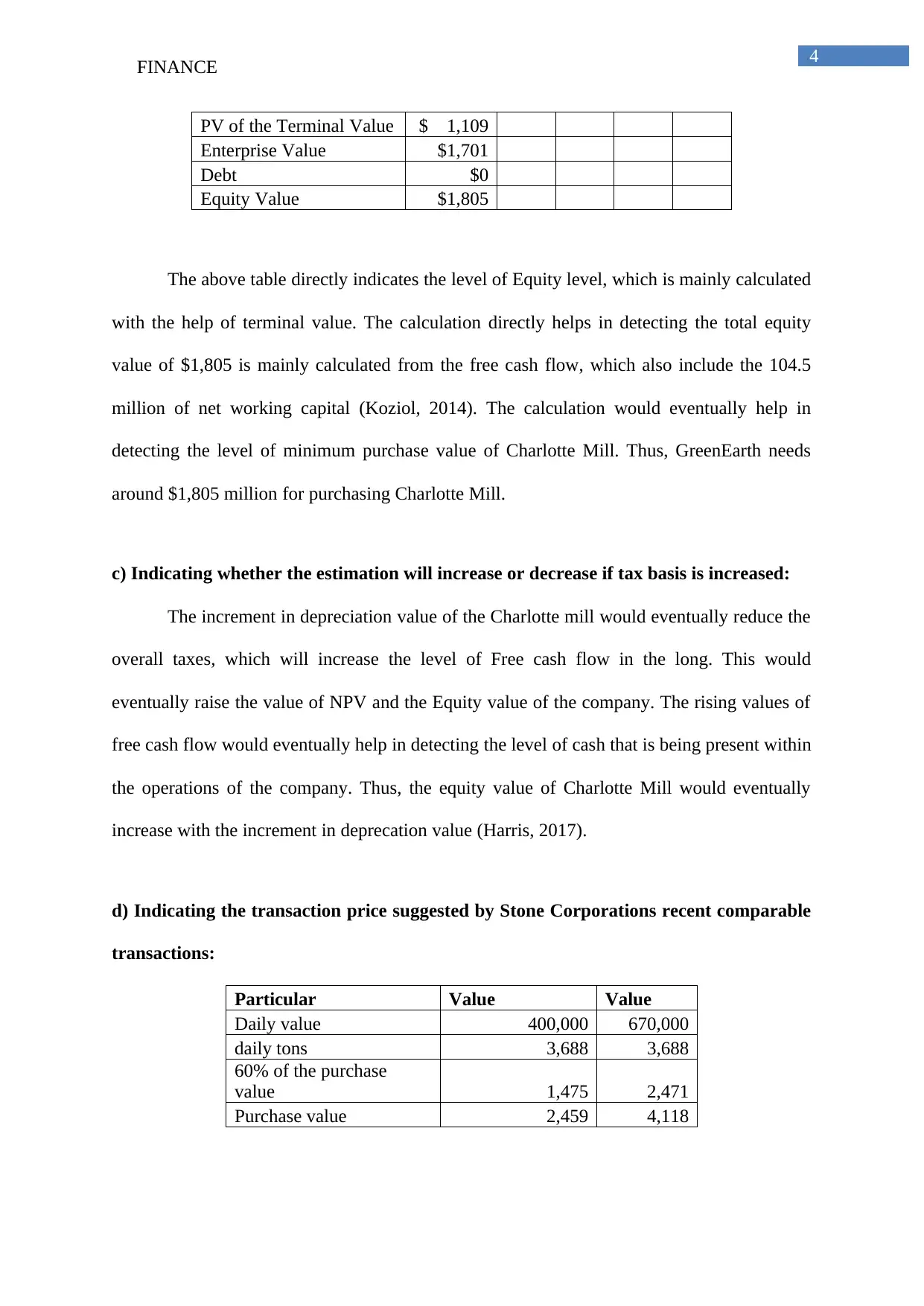
FINANCE 4
PV of the Terminal Value $ 1,109
Enterprise Value $1,701
Debt $0
Equity Value $1,805
The above table directly indicates the level of Equity level, which is mainly calculated
with the help of terminal value. The calculation directly helps in detecting the total equity
value of $1,805 is mainly calculated from the free cash flow, which also include the 104.5
million of net working capital (Koziol, 2014). The calculation would eventually help in
detecting the level of minimum purchase value of Charlotte Mill. Thus, GreenEarth needs
around $1,805 million for purchasing Charlotte Mill.
c) Indicating whether the estimation will increase or decrease if tax basis is increased:
The increment in depreciation value of the Charlotte mill would eventually reduce the
overall taxes, which will increase the level of Free cash flow in the long. This would
eventually raise the value of NPV and the Equity value of the company. The rising values of
free cash flow would eventually help in detecting the level of cash that is being present within
the operations of the company. Thus, the equity value of Charlotte Mill would eventually
increase with the increment in deprecation value (Harris, 2017).
d) Indicating the transaction price suggested by Stone Corporations recent comparable
transactions:
Particular Value Value
Daily value 400,000 670,000
daily tons 3,688 3,688
60% of the purchase
value 1,475 2,471
Purchase value 2,459 4,118
PV of the Terminal Value $ 1,109
Enterprise Value $1,701
Debt $0
Equity Value $1,805
The above table directly indicates the level of Equity level, which is mainly calculated
with the help of terminal value. The calculation directly helps in detecting the total equity
value of $1,805 is mainly calculated from the free cash flow, which also include the 104.5
million of net working capital (Koziol, 2014). The calculation would eventually help in
detecting the level of minimum purchase value of Charlotte Mill. Thus, GreenEarth needs
around $1,805 million for purchasing Charlotte Mill.
c) Indicating whether the estimation will increase or decrease if tax basis is increased:
The increment in depreciation value of the Charlotte mill would eventually reduce the
overall taxes, which will increase the level of Free cash flow in the long. This would
eventually raise the value of NPV and the Equity value of the company. The rising values of
free cash flow would eventually help in detecting the level of cash that is being present within
the operations of the company. Thus, the equity value of Charlotte Mill would eventually
increase with the increment in deprecation value (Harris, 2017).
d) Indicating the transaction price suggested by Stone Corporations recent comparable
transactions:
Particular Value Value
Daily value 400,000 670,000
daily tons 3,688 3,688
60% of the purchase
value 1,475 2,471
Purchase value 2,459 4,118
Paraphrase This Document
Need a fresh take? Get an instant paraphrase of this document with our AI Paraphraser
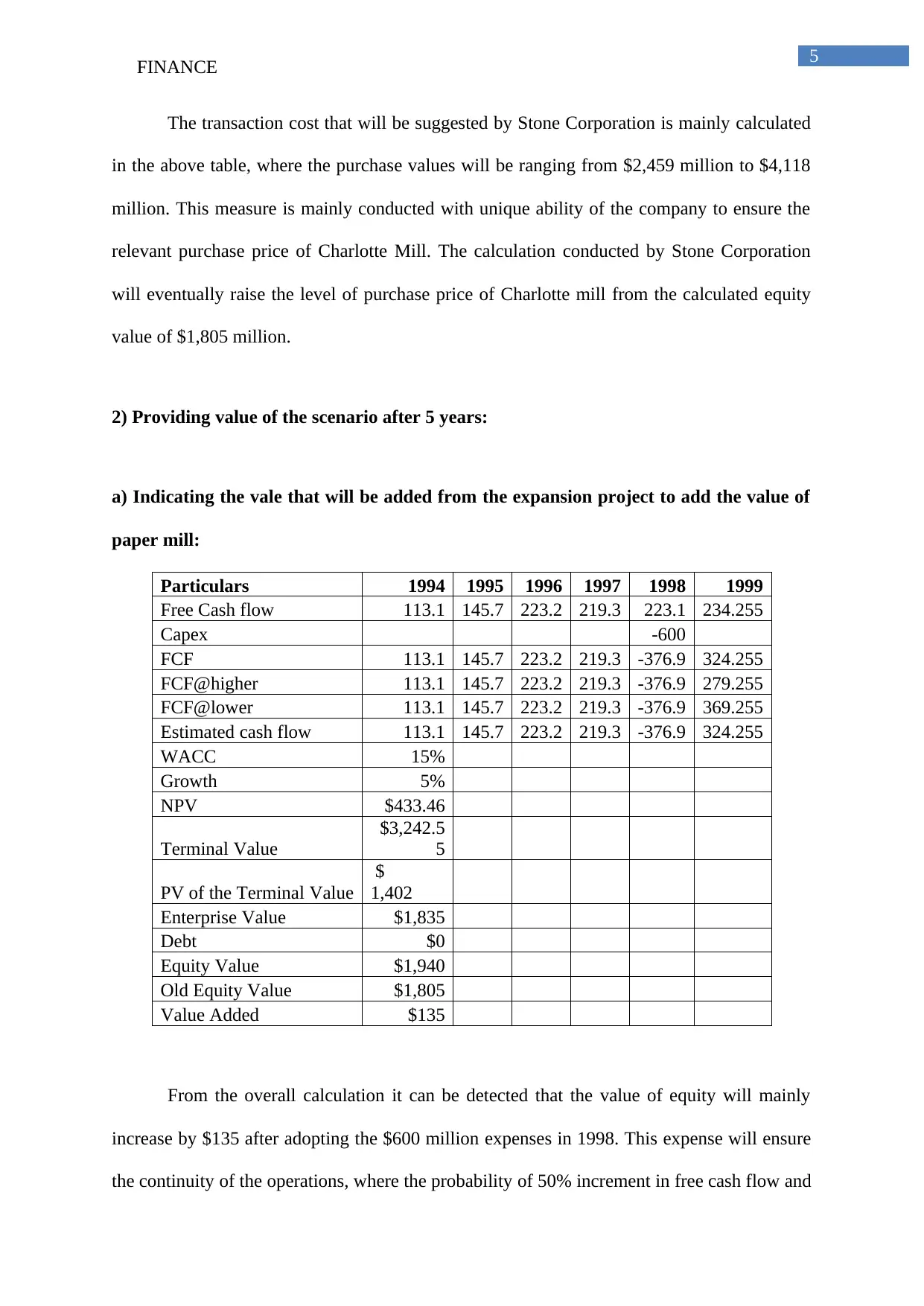
FINANCE 5
The transaction cost that will be suggested by Stone Corporation is mainly calculated
in the above table, where the purchase values will be ranging from $2,459 million to $4,118
million. This measure is mainly conducted with unique ability of the company to ensure the
relevant purchase price of Charlotte Mill. The calculation conducted by Stone Corporation
will eventually raise the level of purchase price of Charlotte mill from the calculated equity
value of $1,805 million.
2) Providing value of the scenario after 5 years:
a) Indicating the vale that will be added from the expansion project to add the value of
paper mill:
Particulars 1994 1995 1996 1997 1998 1999
Free Cash flow 113.1 145.7 223.2 219.3 223.1 234.255
Capex -600
FCF 113.1 145.7 223.2 219.3 -376.9 324.255
FCF@higher 113.1 145.7 223.2 219.3 -376.9 279.255
FCF@lower 113.1 145.7 223.2 219.3 -376.9 369.255
Estimated cash flow 113.1 145.7 223.2 219.3 -376.9 324.255
WACC 15%
Growth 5%
NPV $433.46
Terminal Value
$3,242.5
5
PV of the Terminal Value
$
1,402
Enterprise Value $1,835
Debt $0
Equity Value $1,940
Old Equity Value $1,805
Value Added $135
From the overall calculation it can be detected that the value of equity will mainly
increase by $135 after adopting the $600 million expenses in 1998. This expense will ensure
the continuity of the operations, where the probability of 50% increment in free cash flow and
The transaction cost that will be suggested by Stone Corporation is mainly calculated
in the above table, where the purchase values will be ranging from $2,459 million to $4,118
million. This measure is mainly conducted with unique ability of the company to ensure the
relevant purchase price of Charlotte Mill. The calculation conducted by Stone Corporation
will eventually raise the level of purchase price of Charlotte mill from the calculated equity
value of $1,805 million.
2) Providing value of the scenario after 5 years:
a) Indicating the vale that will be added from the expansion project to add the value of
paper mill:
Particulars 1994 1995 1996 1997 1998 1999
Free Cash flow 113.1 145.7 223.2 219.3 223.1 234.255
Capex -600
FCF 113.1 145.7 223.2 219.3 -376.9 324.255
FCF@higher 113.1 145.7 223.2 219.3 -376.9 279.255
FCF@lower 113.1 145.7 223.2 219.3 -376.9 369.255
Estimated cash flow 113.1 145.7 223.2 219.3 -376.9 324.255
WACC 15%
Growth 5%
NPV $433.46
Terminal Value
$3,242.5
5
PV of the Terminal Value
$
1,402
Enterprise Value $1,835
Debt $0
Equity Value $1,940
Old Equity Value $1,805
Value Added $135
From the overall calculation it can be detected that the value of equity will mainly
increase by $135 after adopting the $600 million expenses in 1998. This expense will ensure
the continuity of the operations, where the probability of 50% increment in free cash flow and
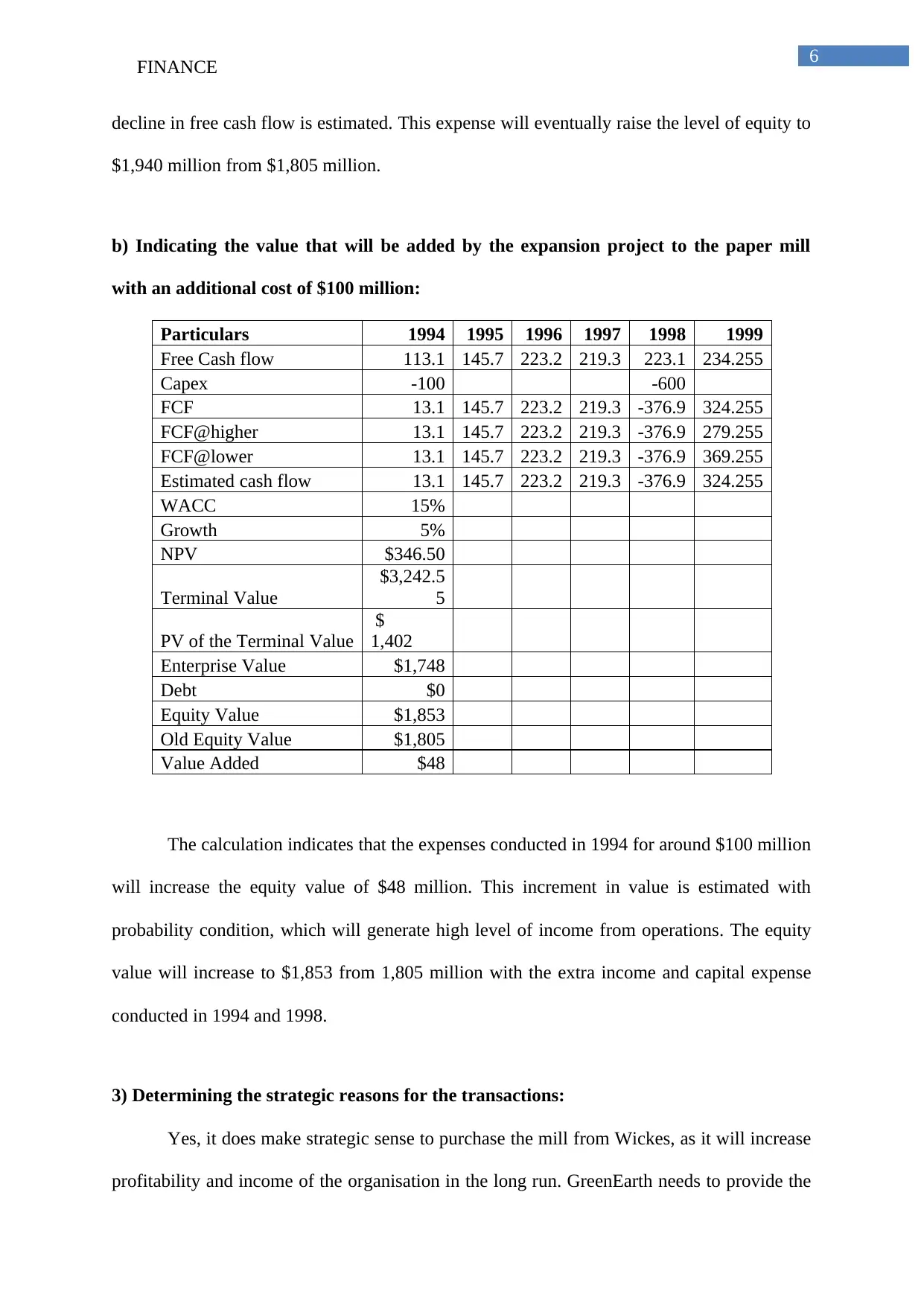
FINANCE 6
decline in free cash flow is estimated. This expense will eventually raise the level of equity to
$1,940 million from $1,805 million.
b) Indicating the value that will be added by the expansion project to the paper mill
with an additional cost of $100 million:
Particulars 1994 1995 1996 1997 1998 1999
Free Cash flow 113.1 145.7 223.2 219.3 223.1 234.255
Capex -100 -600
FCF 13.1 145.7 223.2 219.3 -376.9 324.255
FCF@higher 13.1 145.7 223.2 219.3 -376.9 279.255
FCF@lower 13.1 145.7 223.2 219.3 -376.9 369.255
Estimated cash flow 13.1 145.7 223.2 219.3 -376.9 324.255
WACC 15%
Growth 5%
NPV $346.50
Terminal Value
$3,242.5
5
PV of the Terminal Value
$
1,402
Enterprise Value $1,748
Debt $0
Equity Value $1,853
Old Equity Value $1,805
Value Added $48
The calculation indicates that the expenses conducted in 1994 for around $100 million
will increase the equity value of $48 million. This increment in value is estimated with
probability condition, which will generate high level of income from operations. The equity
value will increase to $1,853 from 1,805 million with the extra income and capital expense
conducted in 1994 and 1998.
3) Determining the strategic reasons for the transactions:
Yes, it does make strategic sense to purchase the mill from Wickes, as it will increase
profitability and income of the organisation in the long run. GreenEarth needs to provide the
decline in free cash flow is estimated. This expense will eventually raise the level of equity to
$1,940 million from $1,805 million.
b) Indicating the value that will be added by the expansion project to the paper mill
with an additional cost of $100 million:
Particulars 1994 1995 1996 1997 1998 1999
Free Cash flow 113.1 145.7 223.2 219.3 223.1 234.255
Capex -100 -600
FCF 13.1 145.7 223.2 219.3 -376.9 324.255
FCF@higher 13.1 145.7 223.2 219.3 -376.9 279.255
FCF@lower 13.1 145.7 223.2 219.3 -376.9 369.255
Estimated cash flow 13.1 145.7 223.2 219.3 -376.9 324.255
WACC 15%
Growth 5%
NPV $346.50
Terminal Value
$3,242.5
5
PV of the Terminal Value
$
1,402
Enterprise Value $1,748
Debt $0
Equity Value $1,853
Old Equity Value $1,805
Value Added $48
The calculation indicates that the expenses conducted in 1994 for around $100 million
will increase the equity value of $48 million. This increment in value is estimated with
probability condition, which will generate high level of income from operations. The equity
value will increase to $1,853 from 1,805 million with the extra income and capital expense
conducted in 1994 and 1998.
3) Determining the strategic reasons for the transactions:
Yes, it does make strategic sense to purchase the mill from Wickes, as it will increase
profitability and income of the organisation in the long run. GreenEarth needs to provide the
⊘ This is a preview!⊘
Do you want full access?
Subscribe today to unlock all pages.

Trusted by 1+ million students worldwide
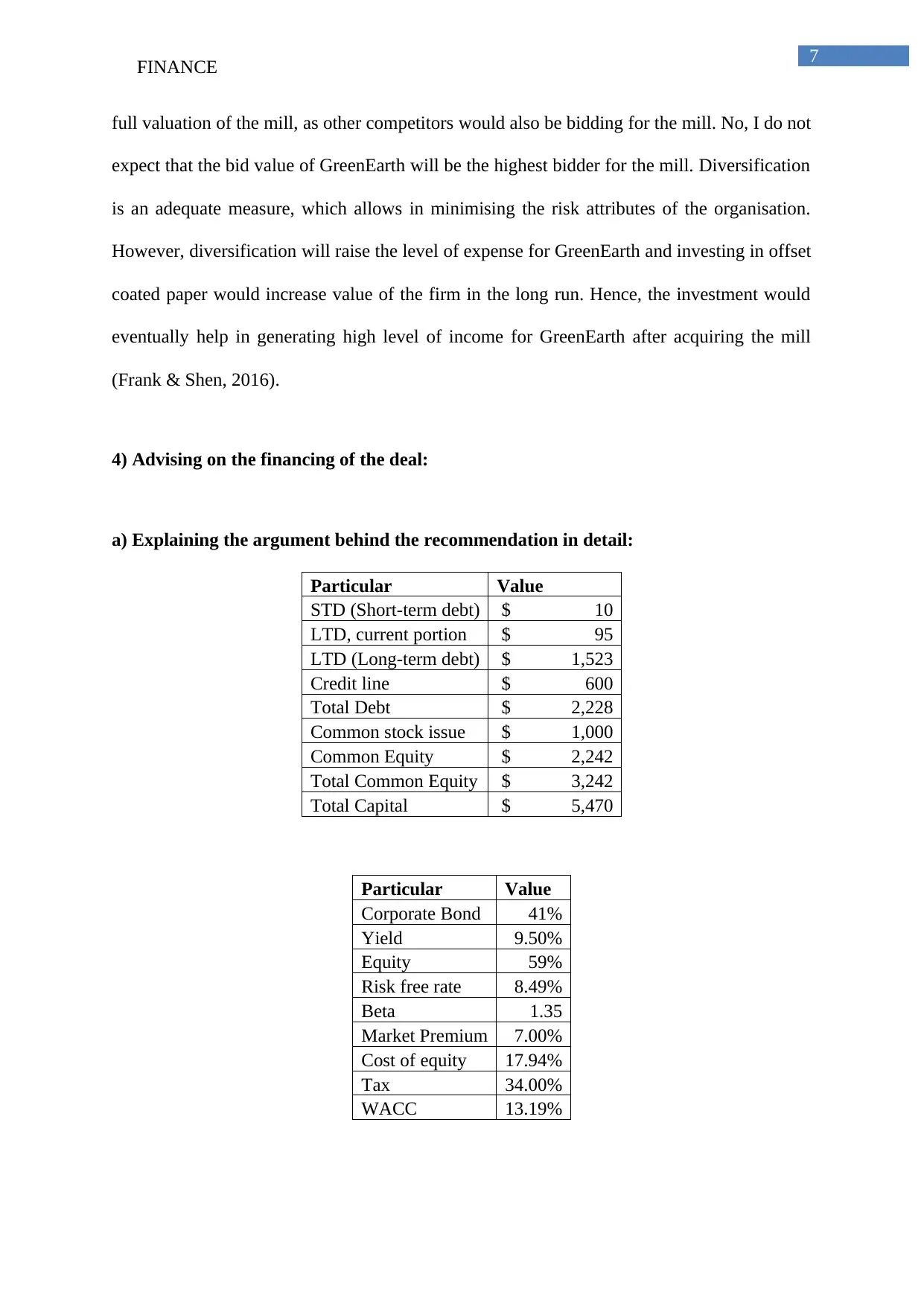
FINANCE 7
full valuation of the mill, as other competitors would also be bidding for the mill. No, I do not
expect that the bid value of GreenEarth will be the highest bidder for the mill. Diversification
is an adequate measure, which allows in minimising the risk attributes of the organisation.
However, diversification will raise the level of expense for GreenEarth and investing in offset
coated paper would increase value of the firm in the long run. Hence, the investment would
eventually help in generating high level of income for GreenEarth after acquiring the mill
(Frank & Shen, 2016).
4) Advising on the financing of the deal:
a) Explaining the argument behind the recommendation in detail:
Particular Value
STD (Short-term debt) $ 10
LTD, current portion $ 95
LTD (Long-term debt) $ 1,523
Credit line $ 600
Total Debt $ 2,228
Common stock issue $ 1,000
Common Equity $ 2,242
Total Common Equity $ 3,242
Total Capital $ 5,470
Particular Value
Corporate Bond 41%
Yield 9.50%
Equity 59%
Risk free rate 8.49%
Beta 1.35
Market Premium 7.00%
Cost of equity 17.94%
Tax 34.00%
WACC 13.19%
full valuation of the mill, as other competitors would also be bidding for the mill. No, I do not
expect that the bid value of GreenEarth will be the highest bidder for the mill. Diversification
is an adequate measure, which allows in minimising the risk attributes of the organisation.
However, diversification will raise the level of expense for GreenEarth and investing in offset
coated paper would increase value of the firm in the long run. Hence, the investment would
eventually help in generating high level of income for GreenEarth after acquiring the mill
(Frank & Shen, 2016).
4) Advising on the financing of the deal:
a) Explaining the argument behind the recommendation in detail:
Particular Value
STD (Short-term debt) $ 10
LTD, current portion $ 95
LTD (Long-term debt) $ 1,523
Credit line $ 600
Total Debt $ 2,228
Common stock issue $ 1,000
Common Equity $ 2,242
Total Common Equity $ 3,242
Total Capital $ 5,470
Particular Value
Corporate Bond 41%
Yield 9.50%
Equity 59%
Risk free rate 8.49%
Beta 1.35
Market Premium 7.00%
Cost of equity 17.94%
Tax 34.00%
WACC 13.19%
Paraphrase This Document
Need a fresh take? Get an instant paraphrase of this document with our AI Paraphraser

FINANCE 8
The combination of credit line and common stock issue would be an effective
measure for securing the capital that will be required for acquiring the mill. The capital from
credit will be at the levels of $600 million, while the common stock issue will be conducted
for $1 billion. The capital structure indicates the debt weighted of the firm to 41%, while the
equity weightage is 59%. Therefore, the capital structure proposed for the organisation is
following the financial policies and the debt is within the confinements of 45%. However, the
inclusion of debt and equity capital has not altered the WACC of the organisation
significantly, which mainly depicts the financial viability of the acquisition of the mill.
b) Indicating the alternation in the decision that will be conducted with the existing
mortgage debt:
Particular Value
STD (Short-term debt) $ 10
LTD, current portion $ 95
LTD (Long-term debt) $ 1,523
Additional debt $ 500
Total Debt $ 2,128
Common stock issue $ 1,000
Common Equity $ 2,242
Total Common Equity $ 3,242
Debentures $ 600
Total Capital $ 5,970
Particular Value
Corporate Bond 36%
Yield 9.50%
Equity 54%
Debentures 10%
D-Yield
10.25
%
Risk free rate 8.49%
Beta 1.35
Market Premium 7.00%
Cost of equity
17.94
%
The combination of credit line and common stock issue would be an effective
measure for securing the capital that will be required for acquiring the mill. The capital from
credit will be at the levels of $600 million, while the common stock issue will be conducted
for $1 billion. The capital structure indicates the debt weighted of the firm to 41%, while the
equity weightage is 59%. Therefore, the capital structure proposed for the organisation is
following the financial policies and the debt is within the confinements of 45%. However, the
inclusion of debt and equity capital has not altered the WACC of the organisation
significantly, which mainly depicts the financial viability of the acquisition of the mill.
b) Indicating the alternation in the decision that will be conducted with the existing
mortgage debt:
Particular Value
STD (Short-term debt) $ 10
LTD, current portion $ 95
LTD (Long-term debt) $ 1,523
Additional debt $ 500
Total Debt $ 2,128
Common stock issue $ 1,000
Common Equity $ 2,242
Total Common Equity $ 3,242
Debentures $ 600
Total Capital $ 5,970
Particular Value
Corporate Bond 36%
Yield 9.50%
Equity 54%
Debentures 10%
D-Yield
10.25
%
Risk free rate 8.49%
Beta 1.35
Market Premium 7.00%
Cost of equity
17.94
%
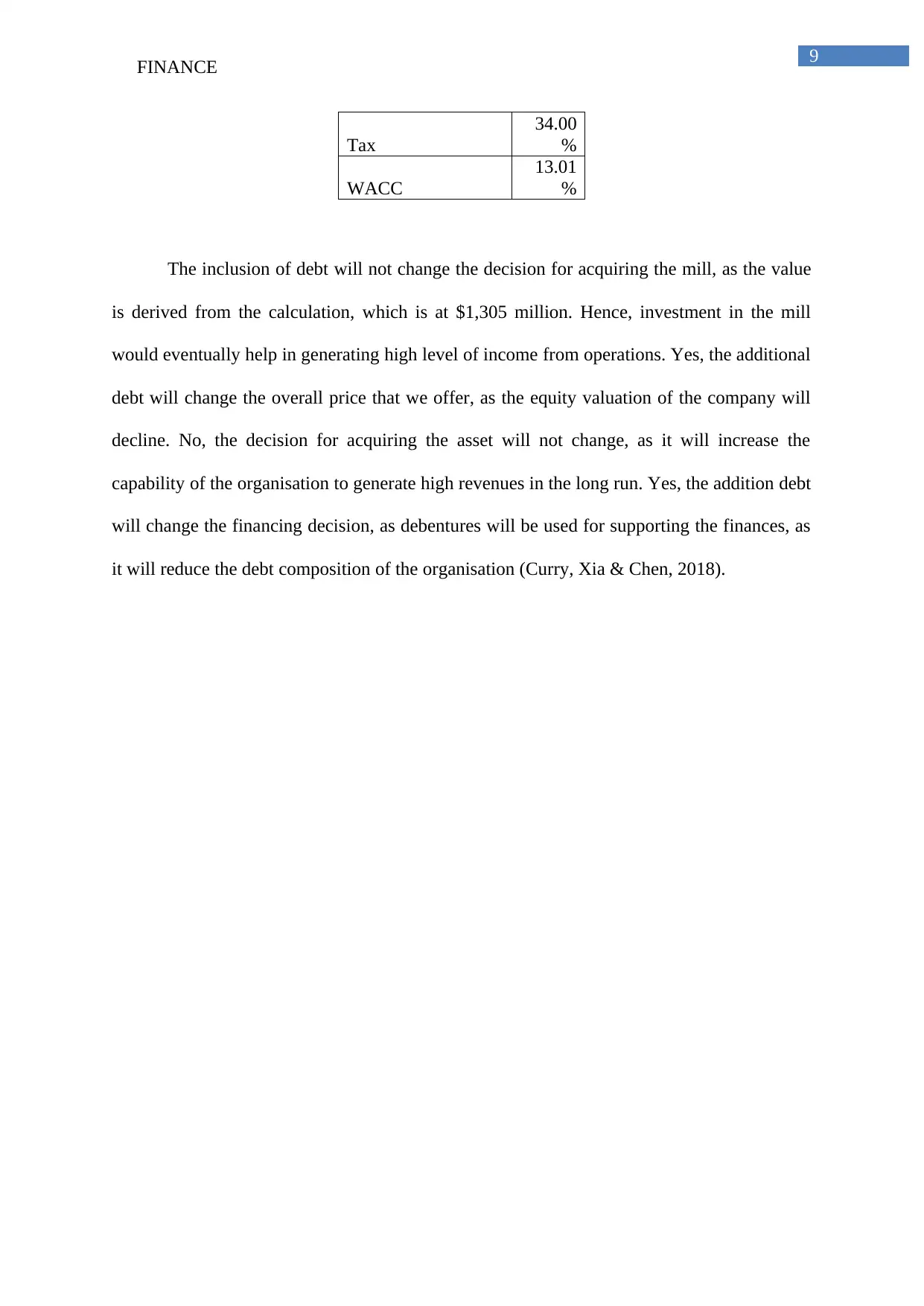
FINANCE 9
Tax
34.00
%
WACC
13.01
%
The inclusion of debt will not change the decision for acquiring the mill, as the value
is derived from the calculation, which is at $1,305 million. Hence, investment in the mill
would eventually help in generating high level of income from operations. Yes, the additional
debt will change the overall price that we offer, as the equity valuation of the company will
decline. No, the decision for acquiring the asset will not change, as it will increase the
capability of the organisation to generate high revenues in the long run. Yes, the addition debt
will change the financing decision, as debentures will be used for supporting the finances, as
it will reduce the debt composition of the organisation (Curry, Xia & Chen, 2018).
Tax
34.00
%
WACC
13.01
%
The inclusion of debt will not change the decision for acquiring the mill, as the value
is derived from the calculation, which is at $1,305 million. Hence, investment in the mill
would eventually help in generating high level of income from operations. Yes, the additional
debt will change the overall price that we offer, as the equity valuation of the company will
decline. No, the decision for acquiring the asset will not change, as it will increase the
capability of the organisation to generate high revenues in the long run. Yes, the addition debt
will change the financing decision, as debentures will be used for supporting the finances, as
it will reduce the debt composition of the organisation (Curry, Xia & Chen, 2018).
⊘ This is a preview!⊘
Do you want full access?
Subscribe today to unlock all pages.

Trusted by 1+ million students worldwide

FINANCE 10
References:
Curry, J., Xia, H., & Chen, K. C. (2018). To Sell or Not to Sell? a Case on Business
Valuation. Journal of the International Academy for Case Studies, 24(2), 1.
Frank, M. Z., & Shen, T. (2016). Investment and the weighted average cost of
capital. Journal of Financial Economics, 119(2), 300-315.
Harris, R. S. (2017). A Comparison of the Weighted-Average Cost of Capital and Equity-
Residual Approaches to Valuation. Darden Business Publishing Cases, 1-5.
Koziol, C. (2014). A simple correction of the WACC discount rate for default risk and
bankruptcy costs. Review of Quantitative Finance and Accounting, 42(4), 653-666.
References:
Curry, J., Xia, H., & Chen, K. C. (2018). To Sell or Not to Sell? a Case on Business
Valuation. Journal of the International Academy for Case Studies, 24(2), 1.
Frank, M. Z., & Shen, T. (2016). Investment and the weighted average cost of
capital. Journal of Financial Economics, 119(2), 300-315.
Harris, R. S. (2017). A Comparison of the Weighted-Average Cost of Capital and Equity-
Residual Approaches to Valuation. Darden Business Publishing Cases, 1-5.
Koziol, C. (2014). A simple correction of the WACC discount rate for default risk and
bankruptcy costs. Review of Quantitative Finance and Accounting, 42(4), 653-666.
1 out of 10
Related Documents
Your All-in-One AI-Powered Toolkit for Academic Success.
+13062052269
info@desklib.com
Available 24*7 on WhatsApp / Email
![[object Object]](/_next/static/media/star-bottom.7253800d.svg)
Unlock your academic potential
Copyright © 2020–2025 A2Z Services. All Rights Reserved. Developed and managed by ZUCOL.





